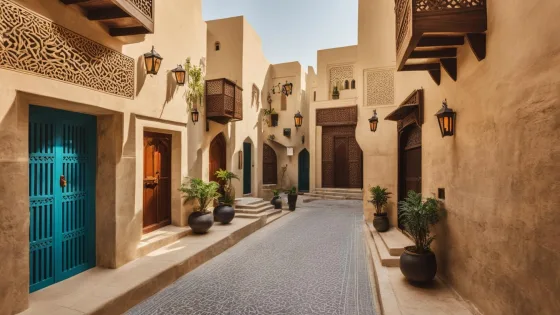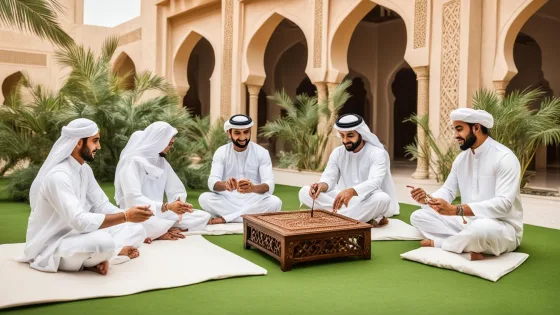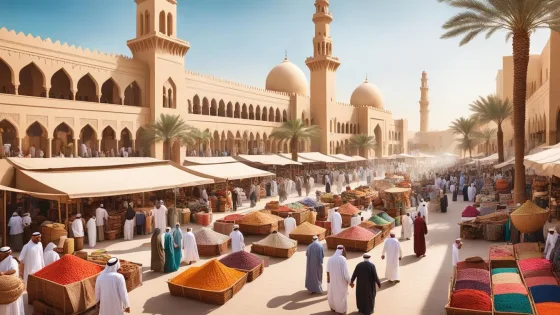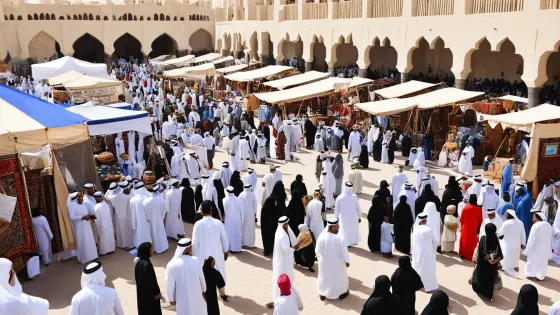Contents
- 1 Exploring the Al Fahidi Historical District
- 2 Dubai’s Past Preserved: Bastakiya Quarter’s 18th-century Architecture
- 3 The Serenity of Dubai Creek and Its Historical Influence
- 4 Historic Sites in Dubai
- 5 Conclusion
- 6 FAQ
- 6.1 What can I expect to see in Dubai Old Town?
- 6.2 What is the significance of the Al Fahidi Historical District?
- 6.3 How has the Al Fahidi Fort transformed over the years?
- 6.4 What architectural features define the Bastakiya Quarter?
- 6.5 What experiences does Dubai Creek offer?
- 6.6 What makes the Spice and Gold Souks special?
- 6.7 Why is the Deira Clocktower historically significant?
- 6.8 Can you tell me about the heritage of Sheikh Saeed Al Maktoum House?
- 6.9 What historical insights can be gained from visiting Al Ahmadiya School?
- 6.10 What is the ‘Wall of Old Dubai’?
- 6.11 What does the Jumeirah Mosque represent?
- 6.12 What discoveries have been made at the Saruq Al Hadid Archaeological Site?
- 6.13 What can I learn from the Saruq Al-Hadid Museum?
Discover a city where history whispers from every corner, beckoning you to explore beyond its iconic skyline. The ancient charm of Dubai Old Town invites you to traverse time and uncover the enchanting Al Fahidi Historical District. This hidden jewel of the city offers a stark contrast to the gleaming modernity—it’s a gateway to the Dubai of bygone days. As you embark on your exploration, you will encounter the whispers of the past, hear the tales of merchants, and see the legacy that has shaped this metropolis.
Your journey through the narrow lanes, flanked by the traditional ‘barjeel’ or wind towers, will leave you captivated by Dubai Old Town’s ancient charm. This is where the city’s heart beats the strongest, in the historic sites of Dubai that have stood the test of time. Prepare to be swept up in the allure of the past, one tangled alleyway at a time, in the Al Fahidi Historical District—a living museum echoing the life that once flourished within its walls.
Key Takeaways
- Experience the contrast of Dubai’s futuristic skyline with the traditional architecture of its historical districts.
- Unearth the Al Fahidi Historical District, where a maze of alleys reveals storied wind towers and the rich tapestry of Dubai’s heritage.
- Witness firsthand how Dubai transformed from a quaint fishing village into a luxurious international destination at the Dubai Museum.
- Explore Alserkal Avenue to discover the city’s creative heartbeat through art galleries and cultural spaces.
- Find tranquility along the peaceful currents of Dubai Creek, offering a serene respite from the urban buzz.
- Immerse yourself in the spiritual heritage of Dubai at the iconic Jumeirah Mosque.
Exploring the Al Fahidi Historical District
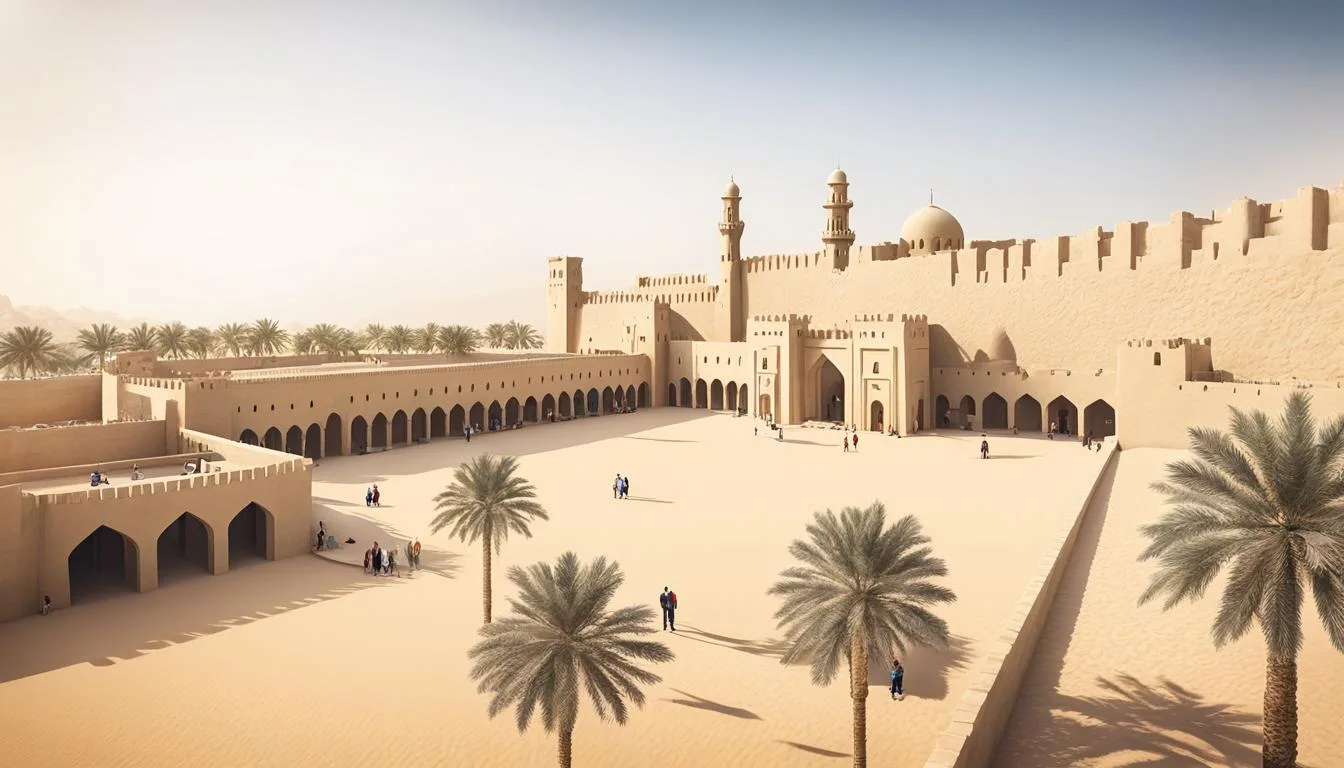
As you step into the Al Fahidi Historical District, you’re swept away by the sands of time to an era where Dubai’s skyline was composed of minarets and wind towers instead of the towering skyscrapers seen today. Within this vibrant district lies not only the spirit of historical Dubai but also an evolution of its cultural identity.
The Labyrinth of Heritage: Narrow Lanes and Wind Towers
Navigating the narrow lanes of the Bastakiya Quarter will transport you to the 18th century, a time when these corridors bustled with the energy of merchants and artisans. You’re surrounded by traditional ‘barjeel’, a remarkable feature of local architecture designed to capture the cool breezes and funnel them into homes, offering respite from the desert heat. These wind towers epitomize the district’s 18th-century architecture, reflecting an era when intelligent design harmonized with the unforgiving climate to foster thriving communities.
Al Fahidi Fort: From Defensive Bastion to Dubai Museum
The centerpiece of Al Fahidi Historical District is the formidable Al Fahidi Fort. This monument’s transformation into the Dubai Museum tells the tale of a city that has embraced modernity while honoring its roots. From its past as a stalwart defense against invaders to its present role as a curator of Dubai’s history, the museum within the fort’s walls offers a fascinating exploration of Dubai’s journey from pearl diving to global economic powerhouse.
Cultural Events and Art Galleries Unveiling the Artistic Side of Dubai
The Al Fahidi Historical District’s artful pulse is palpable in its numerous galleries and cultural events. These venues showcase both local and international artists, creating a colorful mosaic of artistic expression. Year-round, the district bursts into life with vibrant events that celebrate the emirate’s evolving culture, offering you a unique perspective on the artistic side of Dubai, which is often overshadowed by its more modern attractions.
Dubai’s Past Preserved: Bastakiya Quarter’s 18th-century Architecture
Enter the Bastakiya Quarter and step back in time, as you are enveloped by Dubai Old Town’s ancient charm. This cherished part of the city serves as an architectural archive, its narrow lanes lined with the distinctive wind-towered buildings that capture the cool gulf breezes. Each carefully preserved structure stands as a testament to the ingenuity of the 18th-century architecture, making the Bastakiya Quarter a must-visit for anyone yearning to connect with the roots of Dubai’s storied past.
As you meander through the mysterious alleyways, your senses are teased with a collage of vibrant street art that adorns the walls, adding a splash of modern creativity to the historical canvas. The area’s art galleries open their doors wide, inviting you to appreciate the contemporary works of brilliant artists, juxtaposing the city’s rich cultural history with its burgeoning art scene.
Unwind at a local café buried within the historic alleys of Bastakiya and allow the traditions of aromatic Arabic coffee to enhance your immersive journey through Dubai’s heritage.
Leaving behind the well-trodden tourist paths, your exploration of the Bastakiya Quarter bears witness to how seamlessly Dubai’s historic past meets its modern-day vibrancy—an urban tapestry where every stone and every art piece tells a story.
The Serenity of Dubai Creek and Its Historical Influence
The heart of Dubai’s heritage beats along the tranquil waters of Dubai Creek, a serene escape nestled within the bustling city. This historic waterway is not just a picturesque backdrop; it’s steeped in the maritime history that helped shape Dubai into the vibrant global hub it is today. Here, traditional abras glide gently across the water, reflecting a mode of transport that has endured for centuries. Beyond the calm expanse of the creek lies the vibrant legacy of traditional markets: the Spice and Gold Souks, teeming with the essence of old Dubai.
Traditional Abras: A Glimpse into Maritime Heritage
As you set foot on a traditional abra, you step into a living chapter of Dubai’s seafaring narrative. These wooden boats offer more than just a means of crossing from one side to the other; they provide a tangible connection to a bygone era of pearl divers and fishermen who relied on these waters for their livelihood. To truly understand the creek’s integral role in Dubai’s development, there’s no better way than a tranquil abra journey across its waters.
Spice and Gold Souks: The Bustling Markets of Old Dubai
Just a stone’s throw from the creek, the Spice and Gold Souks beckon with their traditional market charm. Wander through narrow alleys lined with shops, each overflowing with vibrant spices, precious metals, and jewels. Exploring these souks, your senses are enticed with the aromatic treasures and visual splendor of a trade hub that’s been thriving for generations, preserving the commercial spirit that’s central to Dubai’s history.
| Spice Souk | Gold Souk |
|---|---|
| Aromatic Spices | Glittering Gold Jewelry |
| Herbs and Incense | Precious Gemstones |
| Traditional Medicine | Expert Craftsmanship |
| Cultural Souvenirs | Authentic Arabesque Designs |
The Deira Clocktower’s Historic Significance
Nearby, the Deira Clocktower stands proud, a sentinel of time marking Dubai’s relentless march towards progress. Erected in the 1960s, the clocktower isn’t just a functional landmark; it symbolizes the city’s transformation and aspirations to reach new heights. Its historic significance is etched in every hour it has counted, being both a witness and a celebration of Dubai’s urban achievements.
Your journey across Dubai’s past is incomplete without acknowledging the historical influence these landmarks have imprinted on the cityscape. Dubai Creek’s serene waters, the bustling energy of the traditional markets, and the iconic Deira Clocktower offer a unique opportunity to experience the cultural depth and historical richness that lies just beneath Dubai’s glittering surface.
Historic Sites in Dubai
The cradle of Dubai’s historical narrative can be found within the walls of its most cherished ancient landmarks. These sites, like the Sheikh Saeed Al Maktoum House and the Al Ahmadiya School, serve as pillars of the city’s rich cultural framework. As you journey through this historic landscape, you bear witness to the sheer depth of Dubai’s roots, from the Sheikh Saeed Al Maktoum House’s heritage, showcasing the lifestyle of the ruling family, to the educational history echoed in the corridors of Al Ahmadiya School.
Cloaked in the sands of time, the Wall of Old Dubai boasts an ancient construction that traces the city’s resilience and innovative spirit of the past. This enduring symbol stands as a testament to the timeless art of traditional architecture, inviting you to touch the textures of history. Beyond the enveloping embrace of the Old City lies the Jumeirah Mosque, not only a spiritual retreat but also an architectural echo of the medieval Fatimid design, welcoming all who seek to understand the beauty of Islamic culture.
Peeling back the layers of Dubai’s storied past is akin to opening a treasure trove. Each site unfolds its own narrative, revealing the city’s transformation across the centuries. Delve into the heart of Dubai’s heritage and walk the very paths where history was written.
In the quietude of these sites, you discover stories of ambition and spirituality that have coursed through the city’s veins, shaping it into the marvel that stands today. The opportunity to explore these venues is more than a simple visit; it’s an immersive experience into the diverse identity of Dubai.
- Sheikh Saeed Al Maktoum House: Step into the private world of Dubai’s ruling elite, imbued with cultural heritage and tradition.
- Al Ahmadiya School:
- Lay the groundwork for understanding Dubai’s progression through educational history.
- Encounter the first national educational institution, a cornerstone of Dubai’s growth.
- Wall of Old Dubai:
- Ambulate alongside an ancient fortress, feeling the embrace of Dubai’s protective past.
- Marvel at the architectural brilliance that sheltered the city throughout centuries.
- Jumeirah Mosque: Engage with the intricate artistry of medieval Fatimid design set in the midst of a modern metropolis.
These historic sites form the narrative arc of Dubai’s epic tale. Witnessing them firsthand is witnessing the harmonious blend of time, where each element narrates a chapter of Dubai’s evolving story.
| Sheikh Saeed Al Maktoum House | Al Ahmadiya School | Wall of Old Dubai | Jumeirah Mosque |
|---|---|---|---|
| Panoramic insights into royal heritage | Chronicles of educational excellence | Tales etched in ancient stone | Expression of medieval splendor amidst modernity |
| Cultural heart of the ruling family | The foundation of academic history in Dubai | Mirror of olden defensive strategy | Symbol of Islamic cultural harmony |
| Preservation of Emirati legacy | Testament to the value of learning and progress | Enduring memories of a fortified past | Architectural bridge between eras |
Conclusion
In wrapping up our journey through the sands of time, it becomes clear that Dubai’s historical narrative is rich with undercurrents of cultural magnitude, hidden beneath its modern gloss. The tales spun by the Saruq Al Hadid Archaeological Site discoveries invite you into a bygone era when the desert sands harbored Iron Age insights, laying bare a past far removed from Dubai’s contemporary opulence. It’s in venues like the Saruq Al-Hadid Museum where these stories spring from relics, offering a poignant window into the lives of our ancestors.
Beyond the emblematic Al Fahidi District and the intricate pathways of Alserkal Avenue, your footsteps echo through the ancient corridors of traditional markets such as the Spice Souk. Carried on the gentle currents of Dubai Creek, you’re reminded that Dubai’s legacy isn’t confined to its spirited skyline but is etched in every abra ride and marketplace transaction. The very heart of Dubai beats to the rhythm of an enduring heritage that steadfastly captures the city’s evolution.
Your exploration of Dubai’s historic sites, inclusive of the archaeological splendors found within the Saruq Al Hadid’s iron-rich soil, is a testament to the power of discovery. As you traverse the landscapes where ancient communities once thrived, you encounter a Dubai unadulterated by time—a city that marvels as much in its centuries-old culture as in its modern architectural feats. For those who seek an experience that interweaves the magnificence of the past with the innovation of the present, Dubai beckons with open arms, promising a passage through time that both enlightens and inspires.
FAQ
What can I expect to see in Dubai Old Town?
Dubai Old Town, known for its ancient charm, is a bustling area filled with historic sites such as the Al Fahidi Historical District. It offers a glimpse into the traditional architecture and lifestyles that once dominated the region. You can explore the narrow lanes, wind towers, and heritage buildings that tell the stories of Dubai’s past.
What is the significance of the Al Fahidi Historical District?
The Al Fahidi Historical District is a crucial link to Dubai’s rich history, with its narrow lanes and preserved wind towers offering an immersive exploration of the city’s heritage. This area is not only architecturally significant but also hosts numerous cultural events and art galleries that highlight the artistic side of Dubai.
How has the Al Fahidi Fort transformed over the years?
The Al Fahidi Fort has evolved from a defensive structure built in the 18th century to an important cultural landmark. Today, it proudly houses the Dubai Museum, where visitors can learn about the emirate’s transformation from a fishing village to a bustling, modern metropolis.
What architectural features define the Bastakiya Quarter?
The Bastakiya Quarter is celebrated for its 18th-century architecture, characterized by high wind towers and traditional courtyard houses made from coral, mud, palm wood, and gypsum. These structures reflect the ingenuity of early residents in adapting to the region’s hot climate.
What experiences does Dubai Creek offer?
Dubai Creek provides a serene escape from the city’s hustle and offers you a chance to experience Dubai’s maritime heritage firsthand with rides on traditional abras (wooden boats). The creek side also features the aromatic Spice and Gold Souks and the iconic Deira Clocktower, each with its own historic significance.
What makes the Spice and Gold Souks special?
The Spice and Gold Souks are traditional markets in Old Dubai that showcase the city’s historical role as a trading hub. The Spice Souk beckons with its multitude of scents and colors, while the Gold Souk dazzles with its extensive collection of jewelry, epitomizing the region’s trade richness.
Why is the Deira Clocktower historically significant?
Erected in the 1960s, the Deira Clocktower serves as a monument to Dubai’s rapid urban development. It marks the gateway to Dubai’s commercial center and stands as a reminder of the city’s ambition and transformative growth over the last half-century.
Can you tell me about the heritage of Sheikh Saeed Al Maktoum House?
Sheikh Saeed Al Maktoum House is the former residential quarters of Dubai’s ruling family and a significant cultural site. This building, with its traditional architecture, showcases the history and lifestyle of Dubai’s ruling elite and offers an extensive archive of historic photographs and documents.
What historical insights can be gained from visiting Al Ahmadiya School?
Al Ahmadiya School, established in 1912, is Dubai’s first educational institute. A visit to this restored school offers you a look into the development of education in Dubai, providing insights into the scholastic practices of the early 20th century and the city’s commitment to literacy and learning.
What is the ‘Wall of Old Dubai’?
The Wall of Old Dubai is an ancient defensive structure that once encircled the settlement. Today, remnants of this wall can be seen and are a testament to the construction techniques and materials used in Dubai’s early history, showcasing the city’s ancient architectural prowess.
What does the Jumeirah Mosque represent?
The Jumeirah Mosque is an exquisite example of medieval Fatimid design, recognized for its intricate artistry and architectural beauty. It is one of the few mosques in Dubai open to non-Muslim visitors, offering an opportunity to appreciate Islamic culture and architecture up close.
What discoveries have been made at the Saruq Al Hadid Archaeological Site?
The Saruq Al Hadid Archaeological Site has revealed a wealth of artifacts dating back to the Iron Age, giving invaluable insights into the region’s past. The findings include metalwork, pottery, jewelry, and weaponry, demonstrating the advanced level of civilization that flourished in this area thousands of years ago.
What can I learn from the Saruq Al-Hadid Museum?
The Saruq Al-Hadid Museum displays a diverse range of artefacts from the Saruq Al Hadid archaeological site, providing an in-depth look at the Iron Age period in the region. Exhibitions illustrate the ingenuity and craftsmanship of the people who lived in Dubai long before it became the city we know today.
